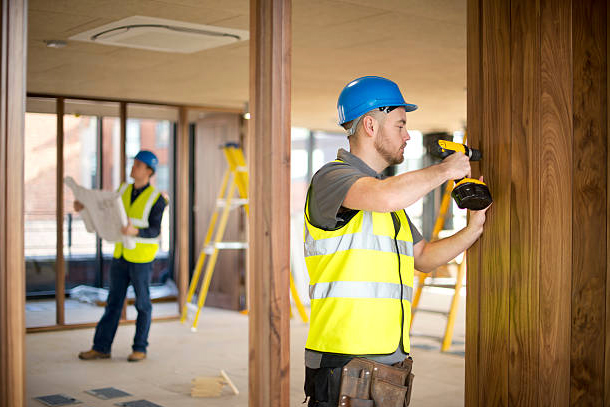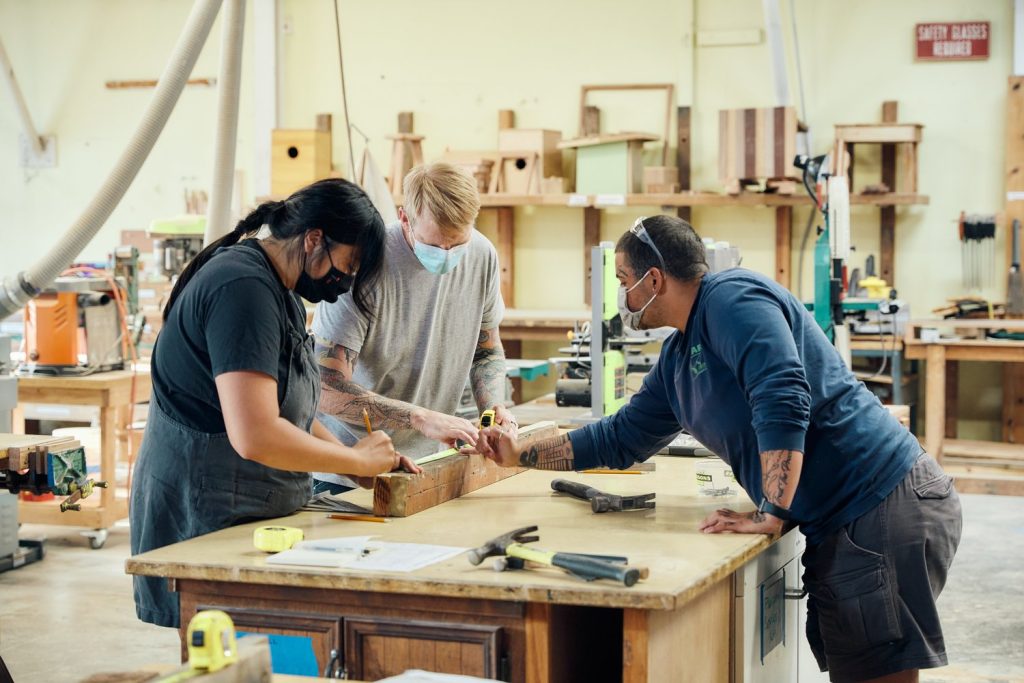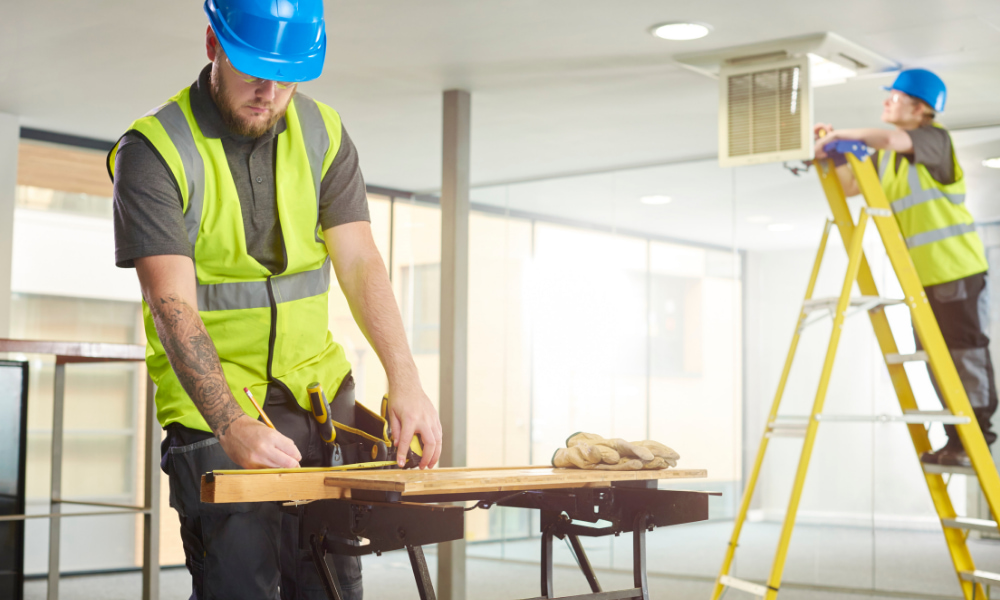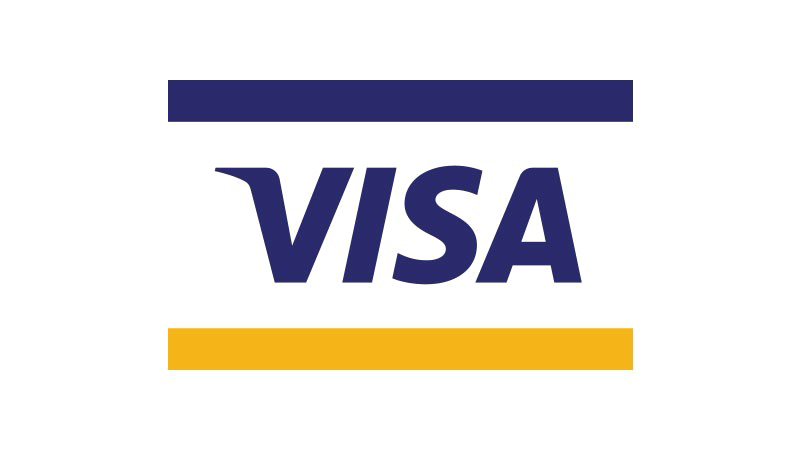When it comes to designing and furnishing a new office space or giving your existing workspace a fresh look, you don’t always have to break the bank. Budget-friendly office fit outs are all about smart planning, strategic choices, and creative solutions that allow you to achieve a functional and visually appealing environment without overspending. In this article, we’ll explore effective strategies for achieving more with less in your office fit outs.
Define Your Priorities in Office Fit out
Before embarking on an office fit out project, it’s crucial to identify your priorities. What aspects of your workspace are most important to your team’s productivity and well-being? Is it open communication areas, ergonomic furniture, or perhaps a welcoming reception space? By pinpointing your priorities, you can allocate your budget where it matters most.

1.Cross-Functional Spaces
Design versatile spaces that can accommodate various functions. A meeting room that can transform into a training area or a lounge that can host informal presentations adds value without the need for separate dedicated spaces
2. Efficient Space Planning
Maximizing the available space is a cornerstone of budget-friendly fit outs. A well-designed layout that optimizes the use of every square foot can help avoid unnecessary construction or expansion costs. Consider open layouts, modular furniture, and versatile storage solutions to make the most of your space.
3. Pre-Owned and Refurbished Furniture
Investigate the possibility of using pre-owned or refurbished furniture. High-quality, gently used furniture can be significantly more affordable than purchasing new items. Refurbishing old furniture pieces can also give them a fresh and updated look, saving you money while contributing to sustainability efforts.
4. Minimalistic Design Approach
Embrace a minimalistic design approach that focuses on clean lines, neutral colors, and functional elements. A clutter-free and cohesive design not only looks visually appealing but can also help you avoid unnecessary expenses on excessive décor.
5. DIY and Repurposing
Get creative by incorporating do-it-yourself (DIY) projects and repurposing items. Upcycling old furniture, creating custom decorations, or even painting walls yourself can add a personal touch to your office fit out while reducing costs.
6. Technology Integration

Invest in technology that enhances productivity and reduces long-term costs. Smart lighting, energy-efficient appliances, and integrated communication systems can make your office more efficient and contribute to savings over time.
7. Flexible Furniture and Layouts
Opt for furniture and layouts that can adapt to changing needs. Flexible workstations and multi-purpose rooms can serve different functions, reducing the need for extensive redesigns or expansions down the line.
8. Strategic Branding
Incorporate your brand identity through strategic choices in color schemes, artwork, and signage. Thoughtful branding can create a visually appealing environment without requiring expensive materials or complex designs.
9. Competitive Bidding
When working with contractors, suppliers, or service providers, solicit multiple quotes to ensure competitive pricing. This can help you secure the best deals and avoid overpaying for services.
10. Long-Term Maintenance Considerations
While focusing on immediate costs is important, also consider the long-term maintenance and operational costs of your fit out choices. Opt for durable materials and energy-efficient solutions that can lead to savings over the lifespan of your office.
A budget-friendly office fit out doesn’t mean sacrificing quality or style. By carefully planning your priorities, making strategic choices, and exploring creative alternatives, you can achieve an attractive and functional workspace without exceeding your budget. With the right approach, you’ll prove that achieving more with less is not only possible but can also result in a workspace that meets your needs and enhances your team’s productivity.
11. Collaborative Workspace Design
Encourage collaboration and interaction among your team members by designing communal areas that foster creativity and teamwork. Incorporate shared workspaces, breakout zones, and collaborative furniture arrangements that promote idea exchange without requiring extravagant investments.

12. Virtual Reality Visualization
Utilize technology to your advantage by using virtual reality (VR) tools to visualize your office fit out before implementation. This can help you make informed decisions about layouts, furniture placement, and overall design, reducing the likelihood of costly design changes later.
13. Multi-Functional Furniture
Choose furniture pieces that serve multiple purposes. For instance, a conference room table with built-in storage or modular seating that can be rearranged for different functions can eliminate the need for purchasing separate items, thereby saving money and space.
14. Renting Furniture
Consider renting furniture for temporary or short-term use. This is especially useful for startups or businesses with rapidly changing needs. Renting furniture items like meeting room chairs or event seating can be more cost-effective than buying them outright.
15. Open Source Design
Explore open-source design resources and templates available online. These resources can provide you with design ideas, layout templates, and even furniture blueprints that you can customize to suit your needs, all at a minimal cost.
16. Local Art and Craftsmanship
Support local artists and craftsmen by incorporating their work into your office fit out. Locally sourced artwork, custom-made furniture, and unique decor pieces can add character to your workspace while also helping the local economy.
17. Energy-Efficient Fixtures
Choose energy-efficient lighting fixtures and appliances that can significantly reduce utility costs over time. LED lighting, motion sensors, and programmable thermostats can create a more sustainable and cost-effective office environment.
18. Employee Involvement
Involve your employees in the design process. Their insights can provide valuable input on what they truly need and help you avoid unnecessary expenses on features that might not be relevant to their daily tasks.
19. Repainting and Refinishing
A fresh coat of paint can work wonders in revitalizing an office space. Repainting walls, refinishing furniture, and updating finishes can give your office a new look without the need for major renovations.
20. Phased Approach
If your budget is limited, consider a phased approach to your office fit out. Start with essential areas and gradually expand or enhance as funds become available. This approach allows you to make progress without compromising quality.
Budget-friendly office fit outs are not about cutting corners, but rather about making thoughtful choices that align with your financial constraints while maintaining a high level of functionality and aesthetics. By combining creativity, resourcefulness, and strategic planning, you can achieve a remarkable office space that reflects your brand, supports your team’s needs, and optimizes your budget. Remember, a successful office fit out is one that maximizes value without sacrificing quality.
21. Sustainable Material Selection
Prioritize sustainable and eco-friendly materials for your office fit out. Recycled materials, low-VOC paints, and renewable resources can contribute to a healthier work environment while aligning with your budget-conscious approach.
22. DIY Decor Elements
Add a personal touch to your office space by creating your own decor elements. Custom artwork, wall murals, and handmade decorations can infuse character into your workspace without the need for expensive art installations.
23. Virtual Meetings Enhancement
Allocate part of your budget to improving your virtual meeting capabilities. Upgrading video conferencing equipment and acoustics can enhance remote communication and reduce the need for expensive in-person gatherings.
24. Employee Wellness Integration
Invest in elements that promote employee well-being, such as ergonomic furniture, standing desks, and relaxation areas. A healthy and comfortable workspace can lead to increased productivity and decreased absenteeism.
25. Data-Driven Design Decisions
Utilize data analytics to guide your design decisions. By analyzing workspace usage patterns and employee preferences, you can tailor your fit out to align with the specific needs of your team, optimizing your budget allocation.
26. Transparent Budget Tracking
Maintain transparency throughout the project by keeping a detailed budget tracker. Regularly update it to monitor expenses and ensure you stay on track, making adjustments as necessary to avoid overspending.
27. Hybrid Work Readiness
Design your office fit out to accommodate hybrid work models. Create spaces that are conducive to both in-person and remote collaboration, anticipating the evolving needs of your team and reducing the need for extensive modifications in the future.
28. Natural Lighting Maximization
Make the most of natural light sources by strategically positioning work areas and utilizing reflective surfaces. Effective use of daylight can reduce the need for excessive artificial lighting, leading to energy savings.
29. Recycling and Upcycling Stations
Designate areas for recycling and upcycling within your office space. Encourage sustainability among your employees by providing spaces for responsible waste disposal and repurposing of materials.
30. Continuous Improvement Mindset
View your office fit out as an ongoing project. Embrace a continuous improvement mindset where you periodically assess the effectiveness of your design and make incremental changes over time to optimize both functionality and cost-efficiency.
A budget-friendly office fit out isn’t just about cost-cutting; it’s about strategic planning, creativity, and making purposeful decisions that align with your business goals. By incorporating these additional strategies into your approach, you can create an office space that not only meets your financial constraints but also fosters a productive, innovative, and inspiring work environment for your team. Remember, achieving more with less requires a balance between resourcefulness and quality.
31. Adaptive Furniture Solutions
Invest in furniture that can adapt to different functions and configurations. Modular workstations, flexible seating arrangements, and collapsible tables can serve various purposes, reducing the need for excessive furniture pieces.
32. Green Walls and Indoor Plants
Integrate greenery into your office fit out with vertical gardens and indoor plants. Not only do they improve air quality and aesthetics, but they also offer a cost-effective way to enhance the overall ambiance of your workspace.
33. Community Sourcing and Bartering
Engage with local businesses and fellow entrepreneurs for potential bartering or collaboration opportunities. Trading goods or services can help both parties achieve their fit out goals without significant financial investments.
34. Remote Work Transition Support
Design your office fit out to facilitate a smooth transition between remote and in-person work. This could include providing hot-desking options, flexible workstations, and technology setups that support seamless remote collaboration.
35. Open Communication Zones
Create informal communication zones within your office. These areas can consist of casual seating and whiteboards where spontaneous discussions and idea-sharing can occur, fostering innovation without the need for complex design elements.
36. Lease Negotiation Considerations
If you’re renting your office space, negotiate with the landlord for potential contributions to your fit out. Landlords might be open to offering rent concessions or covering certain fit out costs as part of your lease agreement.
37. Employee DIY Workshops
Organize workshops for employees to participate in do-it-yourself projects. This not only encourages team-building but also empowers your staff to contribute to the office fit out process, saving costs on professional labor.

38. Subscription-Based Services
Consider subscription-based models for services that are essential for your office, such as printing, cleaning, or office supplies. This approach can provide predictable monthly costs and potential discounts.
39. Brand Consistency Through Graphics
Rather than investing in expensive architectural features, achieve brand consistency through graphic design elements. Wall decals, signage, and digital displays can showcase your brand identity without the need for major construction.
40. Post-Occupancy Evaluation
After completing your office fit out, conduct a post-occupancy evaluation to assess the effectiveness of your design choices. Gather feedback from employees and make adjustments based on real-world usage, ensuring your space continues to evolve efficiently.
Conclusion
Continuing to expand upon the concept of budget-friendly office fit outs, these strategies highlight the importance of adaptability, collaboration, and innovative thinking. By incorporating these additional approaches, you can create a workspace that not only respects your budget constraints but also prioritizes employee well-being, environmental sustainability, and effective resource utilization. Remember, achieving more with less isn’t just a one-time endeavor; it’s an ongoing commitment to finding creative solutions and optimizing your workspace for long-term success.





